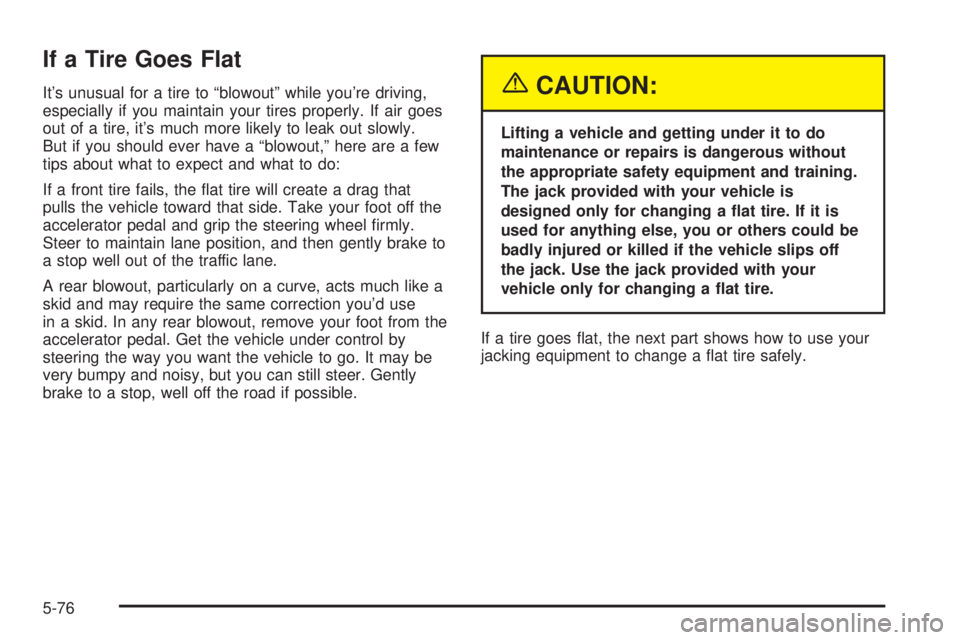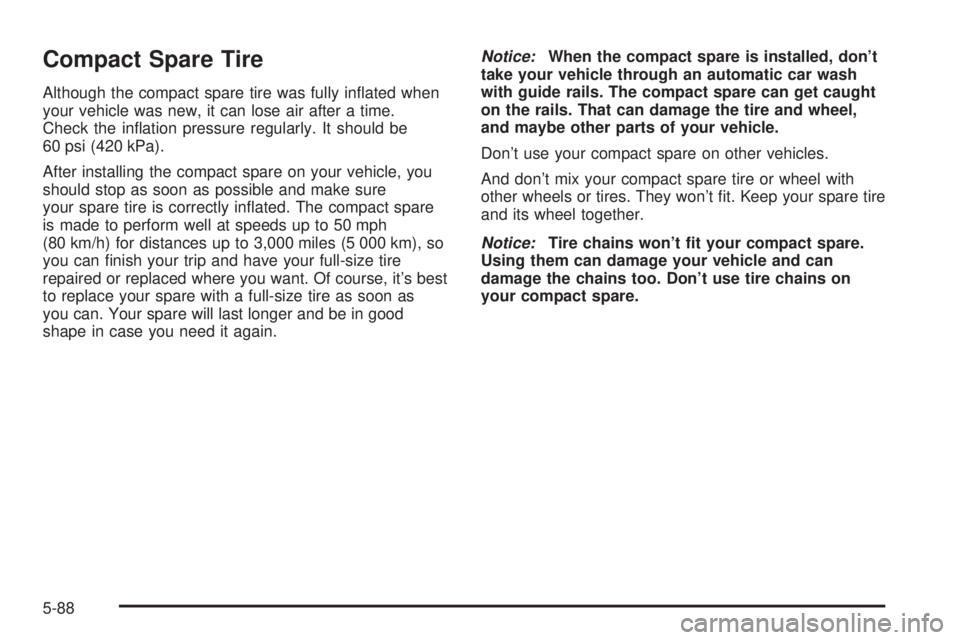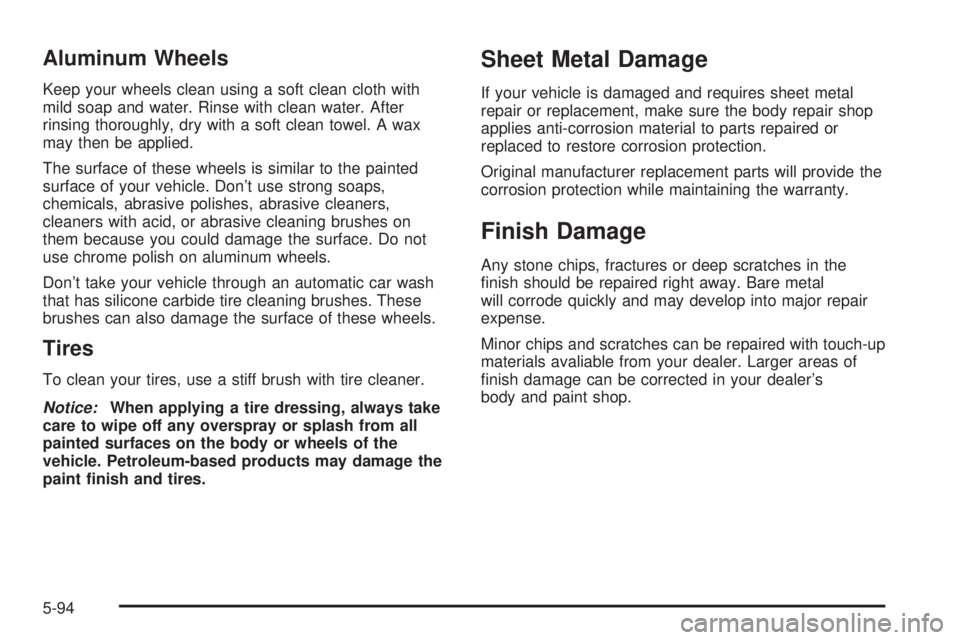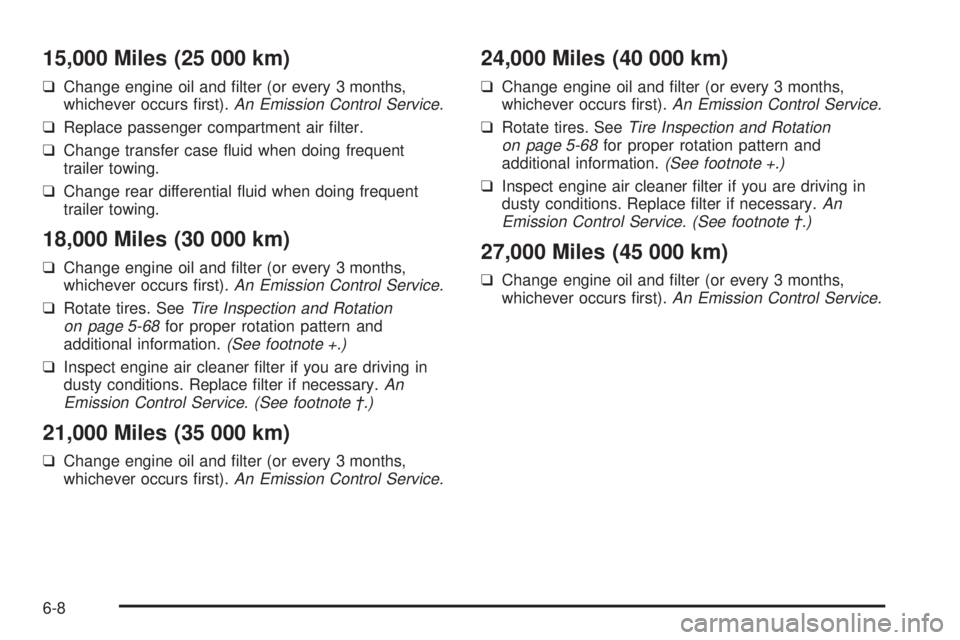tires PONTIAC VIBE 2004 Owner's Guide
[x] Cancel search | Manufacturer: PONTIAC, Model Year: 2004, Model line: VIBE, Model: PONTIAC VIBE 2004Pages: 370, PDF Size: 2.68 MB
Page 285 of 370

Used Replacement Wheels
{CAUTION:
Putting a used wheel on your vehicle is
dangerous. You can't know how it's been used
or how far it's been driven. It could fail
suddenly and cause a crash. If you have to
replace a wheel, use a new GM original
equipment wheel.
Tire Chains
Notice:Use tire chains only where legal and only
when you must. Use only SAE Class ªSº type chains
that are the proper size for your tires. Install them
on the front tires for front-wheel-drive vehicles.
If your vehicle has all-wheel-drive, install the
tire chains on the front or all four tires but never on
the rear tires only. Tighten them as tightly as
possible with the ends securely fastened. Drive
slowly and follow the chain manufacturer's
instructions. If you can hear the chains contacting
your vehicle, stop and retighten them. If the contact
continues, slow down until it stops. Driving too
fast or spinning the wheels with chains on will
damage your vehicle.
5-75
Page 286 of 370

If a Tire Goes Flat
It's unusual for a tire to ªblowoutº while you're driving,
especially if you maintain your tires properly. If air goes
out of a tire, it's much more likely to leak out slowly.
But if you should ever have a ªblowout,º here are a few
tips about what to expect and what to do:
If a front tire fails, the ¯at tire will create a drag that
pulls the vehicle toward that side. Take your foot off the
accelerator pedal and grip the steering wheel ®rmly.
Steer to maintain lane position, and then gently brake to
a stop well out of the traffic lane.
A rear blowout, particularly on a curve, acts much like a
skid and may require the same correction you'd use
in a skid. In any rear blowout, remove your foot from the
accelerator pedal. Get the vehicle under control by
steering the way you want the vehicle to go. It may be
very bumpy and noisy, but you can still steer. Gently
brake to a stop, well off the road if possible.{CAUTION:
Lifting a vehicle and getting under it to do
maintenance or repairs is dangerous without
the appropriate safety equipment and training.
The jack provided with your vehicle is
designed only for changing a ¯at tire. If it is
used for anything else, you or others could be
badly injured or killed if the vehicle slips off
the jack. Use the jack provided with your
vehicle only for changing a ¯at tire.
If a tire goes ¯at, the next part shows how to use your
jacking equipment to change a ¯at tire safely.
5-76
Page 298 of 370

Compact Spare Tire
Although the compact spare tire was fully in¯ated when
your vehicle was new, it can lose air after a time.
Check the in¯ation pressure regularly. It should be
60 psi (420 kPa).
After installing the compact spare on your vehicle, you
should stop as soon as possible and make sure
your spare tire is correctly in¯ated. The compact spare
is made to perform well at speeds up to 50 mph
(80 km/h) for distances up to 3,000 miles (5 000 km), so
you can ®nish your trip and have your full-size tire
repaired or replaced where you want. Of course, it's best
to replace your spare with a full-size tire as soon as
you can. Your spare will last longer and be in good
shape in case you need it again.
Notice:When the compact spare is installed, don't
take your vehicle through an automatic car wash
with guide rails. The compact spare can get caught
on the rails. That can damage the tire and wheel,
and maybe other parts of your vehicle.
Don't use your compact spare on other vehicles.
And don't mix your compact spare tire or wheel with
other wheels or tires. They won't ®t. Keep your spare tire
and its wheel together.
Notice:Tire chains won't ®t your compact spare.
Using them can damage your vehicle and can
damage the chains too. Don't use tire chains on
your compact spare.
5-88
Page 304 of 370

Aluminum Wheels
Keep your wheels clean using a soft clean cloth with
mild soap and water. Rinse with clean water. After
rinsing thoroughly, dry with a soft clean towel. A wax
may then be applied.
The surface of these wheels is similar to the painted
surface of your vehicle. Don't use strong soaps,
chemicals, abrasive polishes, abrasive cleaners,
cleaners with acid, or abrasive cleaning brushes on
them because you could damage the surface. Do not
use chrome polish on aluminum wheels.
Don't take your vehicle through an automatic car wash
that has silicone carbide tire cleaning brushes. These
brushes can also damage the surface of these wheels.
Tires
To clean your tires, use a stiff brush with tire cleaner.
Notice:When applying a tire dressing, always take
care to wipe off any overspray or splash from all
painted surfaces on the body or wheels of the
vehicle. Petroleum-based products may damage the
paint ®nish and tires.
Sheet Metal Damage
If your vehicle is damaged and requires sheet metal
repair or replacement, make sure the body repair shop
applies anti-corrosion material to parts repaired or
replaced to restore corrosion protection.
Original manufacturer replacement parts will provide the
corrosion protection while maintaining the warranty.
Finish Damage
Any stone chips, fractures or deep scratches in the
®nish should be repaired right away. Bare metal
will corrode quickly and may develop into major repair
expense.
Minor chips and scratches can be repaired with touch-up
materials avaliable from your dealer. Larger areas of
®nish damage can be corrected in your dealer's
body and paint shop.
5-94
Page 312 of 370

ApplicationCapacities
English Metric
Manual Transaxle
Five-Speed
Six-Speed2.0 quarts
2.4 quarts1.9 L
2.3 L
Rear Differential 0.5 quarts 0.5 L
Transfer Case 0.8 quarts 0.8 L
Wheels and Tires
Wheel Nut Torque76 lb-ft 103Y
All capacities are approximate. When adding, be sure to ®ll to the approximate level, as recommended in this
manual. See
Part D: Recommended Fluids and Lubricants on page 6-26.
Engine Speci®cations
Engine VIN Code Transaxle Spark Plug Gap
L4
1.8L Engine8 Automatic and Manual 0.043 inch (1.1 mm)
L4
1.8L H.O. DOHC EngineL Automatic and Manual 0.043 inch (1.1 mm)
5-102
Page 321 of 370

Short Trip/City Scheduled
Maintenance
The services shown in this schedule up to 100,000 miles
(166 000 km) should be repeated after 100,000 miles
(166 000 km) at the same intervals for the life of
this vehicle. The service shown at 120,000 miles
(200 000 km) should be repeated at the same interval
after 120,000 miles (200 000 km) for the life of this
vehicle.
See
Part B: Owner Checks and Services on page 6-19andPart C: Periodic MaintenanceInspections on
page 6-24.
Footnotes
²The U.S. Environmental Protection Agency or the
California Air Resources Board has determined that the
failure to perform this maintenance item will not nullify
the emission warranty or limit recall liability prior to
the completion of the vehicle's useful life. We, however,
urge that all recommended maintenance services be
performed at the indicated intervals and the
maintenance be recorded.
+A good time to check your brakes is during tire
rotation. See Brake System Inspection on page 6-25.
3,000 Miles (5 000 km)
qChange engine oil and ®lter (or every 3 months,
whichever occurs ®rst).An Emission Control Service.
6,000 Miles (10 000 km)
qChange engine oil and ®lter (or every 3 months,
whichever occurs ®rst).An Emission Control Service.
qRotate tires. SeeTire Inspection and Rotation
on page 5-68for proper rotation pattern and
additional information.(See footnote +.)
qInspect engine air cleaner ®lter if you are driving
in dusty conditions. Replace ®lter if necessary.
An Emission Control Service. (See footnote ².)
9,000 Miles (15 000 km)
qChange engine oil and ®lter (or every 3 months,
whichever occurs ®rst).An Emission Control Service.
12,000 Miles (20 000 km)
qChange engine oil and ®lter (or every 3 months,
whichever occurs ®rst).An Emission Control Service.
qRotate tires. SeeTire Inspection and Rotation
on page 5-68for proper rotation pattern and
additional information.(See footnote +.)
qInspect engine air cleaner ®lter if you are driving
in dusty conditions. Replace ®lter if necessary.
An Emission Control Service. (See footnote ².)
6-7
Page 322 of 370

15,000 Miles (25 000 km)
qChange engine oil and ®lter (or every 3 months,
whichever occurs ®rst).An Emission Control Service.
qReplace passenger compartment air ®lter.
qChange transfer case ¯uid when doing frequent
trailer towing.
qChange rear differential ¯uid when doing frequent
trailer towing.
18,000 Miles (30 000 km)
qChange engine oil and ®lter (or every 3 months,
whichever occurs ®rst).An Emission Control Service.
qRotate tires. SeeTire Inspection and Rotation
on page 5-68for proper rotation pattern and
additional information.(See footnote +.)
qInspect engine air cleaner ®lter if you are driving in
dusty conditions. Replace ®lter if necessary.An
Emission Control Service. (See footnote ².)
21,000 Miles (35 000 km)
qChange engine oil and ®lter (or every 3 months,
whichever occurs ®rst).An Emission Control Service.
24,000 Miles (40 000 km)
qChange engine oil and ®lter (or every 3 months,
whichever occurs ®rst).An Emission Control Service.
qRotate tires. SeeTire Inspection and Rotation
on page 5-68for proper rotation pattern and
additional information.(See footnote +.)
qInspect engine air cleaner ®lter if you are driving in
dusty conditions. Replace ®lter if necessary.An
Emission Control Service. (See footnote ².)
27,000 Miles (45 000 km)
qChange engine oil and ®lter (or every 3 months,
whichever occurs ®rst).An Emission Control Service.
6-8
Page 323 of 370

30,000 Miles (50 000 km)
qChange engine oil and ®lter (or every 3 months,
whichever occurs ®rst).An Emission Control Service.
qReplace passenger compartment air ®lter.
qReplace engine air cleaner ®lter (or every 24 months,
whichever occurs ®rst).
An Emission Control Service.
qInspect fuel tank, cap, cap gasket and lines for
damage or leaks (or every 24 months, whichever
occurs ®rst). Replace parts as needed.
An Emission
Control Service. (See footnote ².)
qRotate tires. SeeTire Inspection and Rotation on
page 5-68for proper rotation pattern and additional
information.(See footnote +.)
qDrain, ¯ush and re®ll cooling system (or every
24 months, whichever occurs ®rst). SeeEngine
Coolant on page 5-27for what to use. Inspect hoses.
Clean radiator, condenser, pressure cap and neck.
Pressure test cooling system and pressure cap.
An Emission Control Service. (See footnote ².)
qChange manual transaxle ¯uid every 30,000 miles
(50 000 km) only if your vehicle is used to tow a
trailer.qCheck automatic transaxle ¯uid.
qChange transfer case ¯uid when doing frequent
trailer towing.
qChange rear differential ¯uid when doing frequent
trailer towing.
33,000 Miles (55 000 km)
qChange engine oil and ®lter (or every 3 months,
whichever occurs ®rst).An Emission Control Service.
36,000 Miles (60 000 km)
qChange engine oil and ®lter (or every 3 months,
whichever occurs ®rst).An Emission Control Service.
qRotate tires. SeeTire Inspection and Rotation
on page 5-68for proper rotation pattern and
additional information.(See footnote +.)
qInspect engine air cleaner ®lter if you are driving
in dusty conditions. Replace ®lter if necessary.
An Emission Control Service. (See footnote ².)
6-9
Page 324 of 370

39,000 Miles (65 000 km)
qChange engine oil and ®lter (or every 3 months,
whichever occurs ®rst).An Emission Control Service.
42,000 Miles (70 000 km)
qChange engine oil and ®lter (or every 3 months,
whichever occurs ®rst).An Emission Control Service.
qRotate tires. SeeTire Inspection and Rotation
on page 5-68for proper rotation pattern and
additional information.(See footnote +.)
qInspect engine air cleaner ®lter if you are driving
in dusty conditions. Replace ®lter if necessary.
An Emission Control Service. (See footnote ².)
45,000 Miles (75 000 km)
qChange engine oil and ®lter (or every 3 months,
whichever occurs ®rst).An Emission Control Service.
qReplace passenger compartment air ®lter.
qCheck automatic transaxle ¯uid.
qChange transfer case ¯uid when doing frequent
trailer towing.
qChange rear differential ¯uid when doing frequent
trailer towing.
48,000 Miles (80 000 km)
qChange engine oil and ®lter (or every 3 months,
whichever occurs ®rst).An Emission Control Service.
qRotate tires. SeeTire Inspection and Rotation
on page 5-68for proper rotation pattern and
additional information.(See footnote +.)
qInspect engine air cleaner ®lter if you are driving
in dusty conditions. Replace ®lter if necessary.
An Emission Control Service. (See footnote ².)
51,000 Miles (85 000 km)
qChange engine oil and ®lter (or every 3 months,
whichever occurs ®rst).An Emission Control Service.
54,000 Miles (90 000 km)
qChange engine oil and ®lter (or every 3 months,
whichever occurs ®rst).An Emission Control Service.
qRotate tires. SeeTire Inspection and Rotation
on page 5-68for proper rotation pattern and
additional information.(See footnote +.)
qInspect engine air cleaner ®lter if you are driving
in dusty conditions. Replace ®lter if necessary.
An Emission Control Service. (See footnote ².)
57,000 Miles (95 000 km)
qChange engine oil and ®lter (or every 3 months,
whichever occurs ®rst).An Emission Control Service.
6-10
Page 325 of 370

60,000 Miles (100 000 km)
qChange engine oil and ®lter (or every 3 months,
whichever occurs ®rst).An Emission Control Service.
qReplace passenger compartment air ®lter.
qInspect engine accessory drive belts (or every
48 months, whichever occurs ®rst).
An Emission
Control Service.
qReplace engine air cleaner ®lter (or every 24 months,
whichever occurs ®rst).An Emission Control Service.
qRotate tires. SeeTire Inspection and Rotation
on page 5-68for proper rotation pattern and
additional information.(See footnote +.)
qInspect for tappet noise and engine vibration. Adjust
valve clearance to factory speci®cations if necessary
(or every 48 months, whichever occurs ®rst).
An Emission Control Service.
qInspect fuel tank, cap, cap gasket and lines for
damage or leaks (or every 24 months, whichever
occurs ®rst). Replace parts as needed.
An Emission
Control Service. (See footnote ².)
qDrain, ¯ush and re®ll cooling system (or every
24 months, whichever occurs ®rst). SeeEngine
Coolant on page 5-27for what to use. Inspect hoses.
Clean radiator, condenser, pressure cap and neck.
Pressure test cooling system and pressure cap.
An Emission Control Service. (See footnote ².)
qChange manual transaxle ¯uid every 30,000 miles
(50 000 km) only if your vehicle is used to tow a
trailer.
qChange automatic transaxle ¯uid every 60,000 miles
(100 000 km) if the vehicle is mainly driven under
one or more of these conditions:
þ In heavy city traffic where the outside
temperature regularly reaches 90ÉF (32ÉC)
or higher.
þ In hilly or mountainous terrain.
þ When doing frequent trailer towing.
þ Uses such as found in taxi, police or delivery
service.
If you do not use your vehicle under any of these
conditions, check the ¯uid. See Part D: Recommended
Fluids and Lubricants on page 6-26
for the proper
¯uid to use.
qChange transfer case ¯uid when doing frequent
trailer towing.
qChange rear differential ¯uid when doing frequent
trailer towing.
63,000 Miles (105 000 km)
qChange engine oil and ®lter (or every 3 months,
whichever occurs ®rst).An Emission Control Service.
6-11